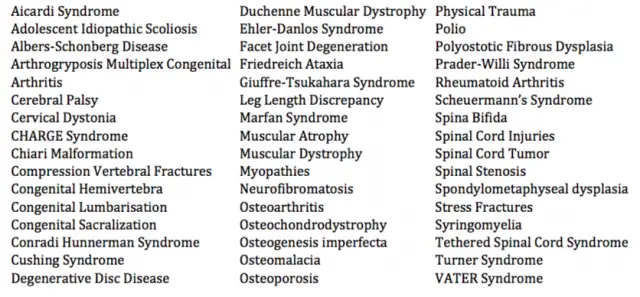
This blog is part of the Analyzing Scoliosis series, which is designed to teach movement practitioners how to work confidently with clients with scoli. This is the first post in the series. My book, Analyzing Scoliosis, which covers the topics in this series (as well as others) in more depth, is available on Amazon.
As a movement practitioner, a client with scoliosis is likely to walk into your studio one day. What is scoliosis, what causes it, and how do I treat it may be some of the few questions running through your head at this point. This blog is the first in a series designed to answer those questions so you can confidently work out and untwist that client. My book, Analyzing Scoliosis, which covers the topics in this series (as well as others) in more depth, is available on Amazon.
What is scoliosis and what will a client look like?
Scoliosis is defined as a lateral bend of the spine of 10 degrees of more. Sounds simple, right? Look at the spine, see that it has a curve that meets the criteria, and boom— it’s diagnosed as scoliosis by a doctor.
Unfortunately, scoli can be much more complex than a spinal curvature, and it can be caused by an almost endless number of circumstances or medical conditions. Often times, it is polycausational, meaning it resulted from many factors. And even with all the research on scoliosis, in many cases the root cause is still unknown in many.
Below is a list of some of the diagnoses in which scoli may present itself. This is not an exhaustive list, but you’ll see that the root cause of scoliosis can come from many different places.

Seriously, ALL of those things can cause scoliosis? Yeah, my head is spinning, too.
Fortunately, there’s no need to know the intricacies of all the diagnoses and conditions above – I just wanted to make a point. And that point is: not all scoliosis cases stem from the same source, therefore not all scoliosis clients will look or move the same. Actually, you can almost guarantee that most scoli clients will look and move completely different from one another.
Your scoli clients will come to you in all sorts of different shapes, sizes, age groups, and physical ability levels. No matter what, when you meet a client who has a diagnosis of scoliosis, I want you to have the tools to confidently say, “Yes, I’d love to work with you. Yes, I think I can help your body. And no, your scoli doesn’t scare me.”
In future posts I’ll discuss what I’ve learned about how to work with the most common types of scoliosis and share the techniques I’ve developed to analyze scoliosis clients. So, don’t get overwhelmed by the lack of an average client or all the obscure diagnoses that can cause scoliosis because I’ve got your back.

Leave a Reply